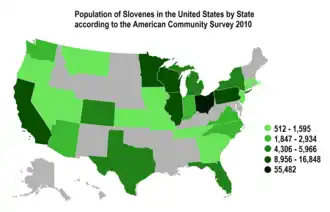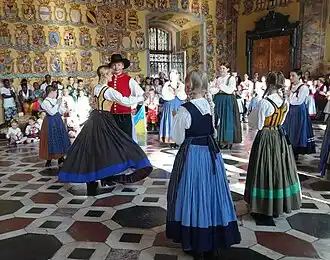Slovenian Americans are U.S. citizens who can trace their family heritage back to Slovenia, a small country in Central Europe (current population of 2.1 million). Slovenia is bound by Italy to the west, Austria to the north, Hungary to the northeast and Croatia to the south.
Slovenia's turbulent history[1] stretches from a Roman province to medieval rule under the Franks and the Holy Roman Empire. After the 14th century Slovenia flourished within the Habsburg and the subsequent Austro-Hungarian Empires. After World War I Slovenia was partly dismembered with its western regions being absorbed by fascist Italy. Later it became one of the constituent republics of the newly formed Yugoslavia. Slovenia finally gained independence in 1991, later joining both the European Union and NATO.
Research your ancestors on MyHeritage
Slovenian migration to the USASlovenian migration to the USA
Slovenians began migrating to the United States in significant numbers during the second half of the 19th century[2]. The peak of emigration occurred between 1880 and World War I. Slovenian migrants came to the U.S. mainly to escape harsh economic conditions at home. After World War II, with Yugoslavia having become a communist country, Slovenian migration was also increasingly driven by a desire for political freedoms.

The early waves of migration primarily consisted of single men working in unskilled labour sectors like mining and steel production. Later women and families followed leading to the establishment of recognisable Slovenian communities in the U.S. Slovenian migrants were especially drawn to the industrial cities and mining towns of the Midwest. By 1914 Cleveland was considered the third most populous Slovene city globally, after the Trieste and Ljubljana. Subsequent waves of migration occurred after World War I (1919–1923) and again after World War II (1949–1956). In each wave letters from earlier emigrants describing their improved lives in America fuelled further Slovenian migration.
Around 180,000 Americans identified as having Slovenian ancestry in the 2020 U.S. Census. However other estimates put the number at between 300,000 and 600,000, including those who do not explicitly draw on their Slovenian heritage.
Today Ohio still represents the strongest concentration of the U.S. Slovenian community. Other states with notable Slovenian populations include Pennsylvania, Illinois, Minnesota, Wisconsin, California, Colorado, Florida and Texas[2].
Maintaining Slovenian identity in the USAMaintaining Slovenian identity in the USA

Like many other migrant groups Slovenian Americans have sought to maintain elements of their culture and identity through a variety of means even while embracing their new country. Community organisations, religious festivals and practices, cultural and food traditions and promoting the Slovene language have all played a part in linking Slovenian Americans to their old homeland:
- Slovenian cultural centres and social clubs have served as hubs for social gatherings, celebrations and cultural preservation. Among the key entities are the Slovenian National Home in Indianapolis, the Slovenian Union of America Groups and the Slovene National Benefit Society (SNPJ). These host social events, language classes and folk performances aim at reinforcing Slovenian community identity.
- As Roman Catholicism has played a significant role in the lives of many Slovenian immigrants local Catholic churches have often become central to their communities, hosting religious events, festivals and other cultural activities. The American Slovenian Catholic Union (KSKJ) provides practical support like mutual aid and insurance while promoting traditional Slovene customs.
- Many families have encouraged their children to learn the Slovene language through weekend schools or at home. Slovene-language publications, newspapers and radio programs (including programming available online in English from the Slovenian national broadcaster Radiotelevizija Slovenija (RTV) all aim to foster language retention.
- Choral groups like the Zarja Singing Society and The Singing Slovenes have helped preserve Slovenian folk music traditions.
- Slovenian organisations like the American Slovenian Education Foundation (ASEF) have led efforts to document and digitize Slovenian cultural elements, such as archives, books, and memorabilia to preserve and provide easier access for Americans seeking to maintain a link to their Slovenian ancestry.
Slovenian American surnamesSlovenian American surnames
Notwithstanding efforts to maintain links to their heritage as a practical matter many Slovenian immigrants to the USA have anglicized their surnames. The motivation in many cases was as simple as accommodating the English phonetic spelling of their Slovenian name because they found people could not pronounce or spell the original name. For others it may have been a way of demonstrating affiliation to their new country.
There is a separate Wiki article which describes the many variations of Slovenian names to be found in the U.S. and other migrant countries.
Researching Slovenian AmericansResearching Slovenian Americans
To research Slovenian American ancestry or cultural heritage, you can use several resources and strategies.
- U.S. immigration documents: Researching these records, which can be done via MyHeritage, will help you identify ancestral villages and correct time period. In this way you can narrow your search and ensure that you’re focusing on the right person. This is especially important if the person you are researching a common Slovenian surname noting that the same surname and even the same forename can be repeated in the same village through multiple generations.
- Genealogy Resources: These include Matricula Online to access digitized vital (birth, death, marriage) records held in Slovenian parish churches and the SNPJ Heritage Center which provides genealogy tools, including family tree CDs, Social Security records and genealogy research publications to help you research Americans of Slovenian origin.
- Facebook Groups: the Slovenian Genealogy (Genealogy2000) group has over 6,300 members and provides English-language guidance, local archive access and help from other community members to find and access offline records.
- Cultural Organizations: in addition to the Slovenian organisations listed above the Slovenian Union of America (SUA), headquartered in Joliet, IL (but with branches in multiple other states) offers access historical records and publishes a regular magazine Zarja, with helpful articles on Slovenian genealogical research.
- Archives and Museums: the Slovenian Museum and Archives (Cleveland) and the National Cleveland-Style Polka Hall of Fame are a good starting point for research of Slovenian immigrant cultural artifacts.
Notable Slovenian AmericansNotable Slovenian Americans

While only a small community there are some notable Americans of Slovenian heritage. Among the most prominent individuals across entertainment, politics, science are sports are:
- Melania Trump: First Lady of the U.S., born Melanija Knavs in Novo Mesto, Slovenia.
- Amy Klobuchar: U.S. Senator for Minnesota.
- George Dolenz: Actor known for The Count of Monte Cristo (1956); father of Micky Dolenz of The Monkees fame and grandfather of Ami Dolenz, an actress known for Can’t Buy Me Love (1987).
- Frankie Yankovic: Grammy-winning “Polka King” born to Slovene immigrants who popularized Slovenian-style polka music.
- "Weird Al" Yankovic: Comedy performer known for his parodies of pop music.
- Anthony Jeselnik: Comedian and writer, best known for the 2025 TV series Thoughts and Prayers.
- Actors Frank Gorshin (Batman’s Riddler) and Željko Ivanek (Damages, Argo).
- NASA Astronauts Sunita Williams, Ronald Sega (also former Undersecretary of the Air Force), Randy Bresnik and Jerry Michael Linenger.
- Peter Vidmar: Gymnast and one of only three athletes twice inducted into the U.S. Olympic Hall of Fame.
See alsoSee also
Explore more about Slovenian AmericansExplore more about Slovenian Americans
MyHeritage has a variety of resources where you can begin your Slovenia research. For example there are more than 1 million individuals born in Slovenia in tens of thousands of family trees created by MyHeritage members.
Other resources to consider:
- Status Animarum (Latin for “state of souls” ): are records documenting the religious activity of people in a particular Catholic parish. Kept by the parish priest, status animarum typically contain family names, relationships, birth dates, house numbers, house "name" (see the Wiki article on Slovenia for an explanation of these) and sacraments they have taken such as confirmation, confession, communion, marriage and last rights. For some Slovenian parishes these are available through directly through local parish archives. A publication, Vodnik po župnijskih arhivih (Guide to parish archives, is available through the Slovenian Genealogical Society International. The SGSI also provides research assistance and (paid) access to U.S. Slovenian immigrant records.
- Slovenian Public Archival Network: A Slovenian government website provides access to otherwise hard to find material such as historical archival documents created by land seigniories, families, or individuals who were important for the course of Slovenian history as far back as the 13th century. It also links regional archival collections across Slovenia as well as a limited number of Slovenian church archives. An English version is available.
- Published Guides: These include Researching Your Slovenian Ancestors: A foundational English-language guide for navigating Slovenian genealogical sources by Branka Lapajne.
- Peter Hawlina: The well-known Slovene genealogist's website has a valuable guide to doing genealogical research on Slovenian roots from abroad.

